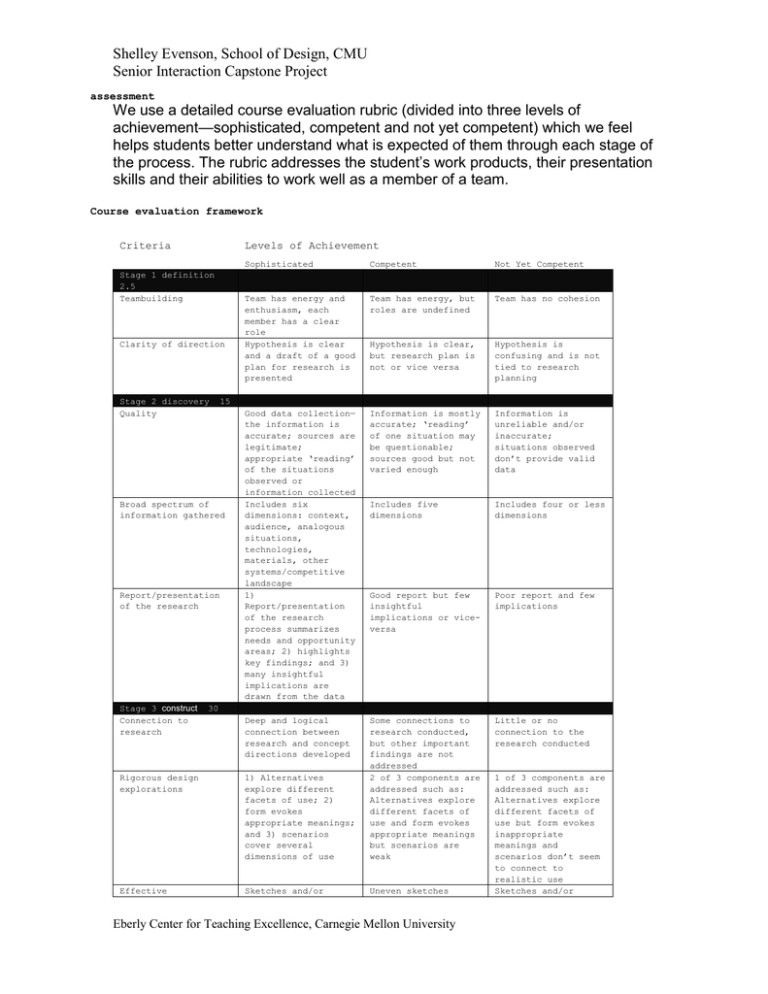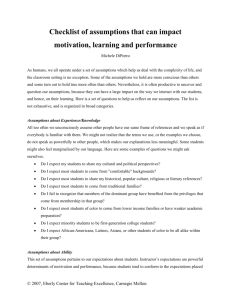Shelley Evenson, School of Design, CMU Senior Interaction Capstone Project
advertisement

Shelley Evenson, School of Design, CMU Senior Interaction Capstone Project assessment We use a detailed course evaluation rubric (divided into three levels of achievement—sophisticated, competent and not yet competent) which we feel helps students better understand what is expected of them through each stage of the process. The rubric addresses the student’s work products, their presentation skills and their abilities to work well as a member of a team. Course evaluation framework Criteria Levels of Achievement Stage 1 definition 2.5 Teambuilding Clarity of direction Stage 2 discovery Quality Stage 3 construct Connection to research Competent Not Yet Competent Team has energy and enthusiasm, each member has a clear role Hypothesis is clear and a draft of a good plan for research is presented Team has energy, but roles are undefined Team has no cohesion Hypothesis is clear, but research plan is not or vice versa Hypothesis is confusing and is not tied to research planning Good data collection— the information is accurate; sources are legitimate; appropriate ‘reading’ of the situations observed or information collected Includes six dimensions: context, audience, analogous situations, technologies, materials, other systems/competitive landscape 1) Report/presentation of the research process summarizes needs and opportunity areas; 2) highlights key findings; and 3) many insightful implications are drawn from the data Information is mostly accurate; ‘reading’ of one situation may be questionable; sources good but not varied enough Information is unreliable and/or inaccurate; situations observed don’t provide valid data Includes five dimensions Includes four or less dimensions Good report but few insightful implications or viceversa Poor report and few implications Deep and logical connection between research and concept directions developed Little or no connection to the research conducted 15 Broad spectrum of information gathered Report/presentation of the research Sophisticated 30 Rigorous design explorations 1) Alternatives explore different facets of use; 2) form evokes appropriate meanings; and 3) scenarios cover several dimensions of use Some connections to research conducted, but other important findings are not addressed 2 of 3 components are addressed such as: Alternatives explore different facets of use and form evokes appropriate meanings but scenarios are weak Effective Sketches and/or Uneven sketches Eberly Center for Teaching Excellence, Carnegie Mellon University 1 of 3 components are addressed such as: Alternatives explore different facets of use but form evokes inappropriate meanings and scenarios don’t seem to connect to realistic use Sketches and/or Shelley Evenson, School of Design, CMU Senior Interaction Capstone Project communication of form and content directions prototypes and scenarios of use bring opportunity areas to life and/or prototypes so that it takes lots of explanation to communicate and it is more difficult to imagine actual use Eberly Center for Teaching Excellence, Carnegie Mellon University prototypes don’t get ideas across; Shelley Evenson, School of Design, CMU Senior Interaction Capstone Project Stage 4 refine 10 Product evaluation Quality of craftsmanship and level of completion Stage 5 reflect 25 Product|project brief and quality of the team’s reflection on a design solution Poster Presentation content Presentation delivery Connections Progress reports 5 Quality Self-evaluation 10 Analysis of group process and individual role within it Team used systematic testing to validate or drive refinement 1) Final direction works well—the form and the interaction are seamless and 2) it looks great and 3) its complete Used very informal feedback to drive refinement Only 2 of the 3 components are addressed such as it works well and looks great, but it’s incomplete No testing or feedback Documents process, explains ideas well, clear introduction and conclusion, obvious transitions, doesn’t use jargon, demonstrates knowledge of key points Is an effective summary of the team’s efforts and works visually Document is coherent for the most part, but missing 1 or 2 important elements Document lacks coherence and is missing 3 or more important Is an effective summary of the team’s efforts and doesn’t work visually or vice versa For the most part slides are helpful in telling the story with only a few glaring problems Is not an effective summary and does not work visually Presentation is polished, for the most part, but missing 1 or 2 important elements Presentation is not polished Some components relate and others do not Brief, presentation and poster feel as though different people produced them Goals, accomplishments and time are covered; completed each week Goals, accomplishments and time are covered; but are not completed each week or vice versa Goals, accomplishments and time are not covered; not completed each week Clearly articulates what worked well and why, what did not work well and why, and ways to increase effectiveness and efficiency of group process in the future, considering self as Discusses only two of the three; discusses group without discussing self; discusses self without discussing group Does not articulate any of the three – what worked well and why, what didn’t work well and why, how to improve Effective slides with coherent and logical progression, covers all key points, slides clearly aid the speaker in telling a coherent story Presentation is polished, speakers use sentences, enunciates well, maintains an effective pace and eye contact, doesn’t run over allotted time Brief, poster and presentation build and enhance one another Eberly Center for Teaching Excellence, Carnegie Mellon University Final direction would fail in use and either the interaction or product form are unfinished Slides interfere with the story Shelley Evenson, School of Design, CMU Senior Interaction Capstone Project well as others Participation 2.5 Active participation Active participation in projects, assignments, attendance/discussions, and critiques Some participation Eberly Center for Teaching Excellence, Carnegie Mellon University Little participation


